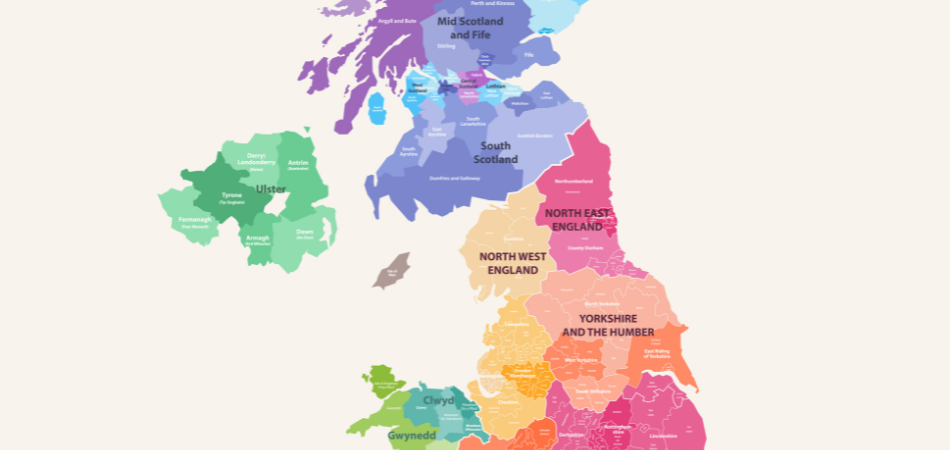
Written by:
Last Updated:
May 29th, 2025
Whilst alcohol mortality is increasing globally, the number of alcohol-related deaths in the northern areas of England is particularly increasing. Alcoholism doesn’t discriminate. However, it is the case that some areas and key demographics are disproportionately affected by substance use disorders.
Clinical data indicates that specific demographics are more likely to experience addiction. However, alcohol mortality isn’t just about who experiences addiction. It is also about who is able to access appropriate alcohol help in order to reduce their risk of long-term illness and, ultimately, death.
Alcohol mortality: The global picture
Statistics suggest alcohol mortality is increasing internationally. The increase is attributed to an increase in heavy drinking, but also the development of alcohol-related health issues associated with the longitudinal impacts of alcohol.
Globally
The World Health Organization indicates that there are 3 million deaths related to alcohol per year. This equates to around 5.3% of all deaths internationally. To contextualise this, we can look at the world population, which currently stands at 8.1 billion.
England
In England, however, there were 21,912 alcohol-related deaths in 2022. This works out to around 39.7 alcohol-related mortalities per 100,000 people. The estimated population of England in 2022 was 60.2 million.
Of these deaths,
- 7,912 were classed as ‘alcohol-specific,’
- 5,868 people under 75 died from alcohol-related liver disease
- 13,269 people over 75 died from alcohol-related liver disease
- 8,080 people died from chronic liver disease
The data also calculate ‘potential years of life lost’ due to alcohol-related conditions.
- Collectively, for males, this stands at 322,188 years lost.
- Collectively, for females, this stands at 151,422 years lost.
There were 948,312 hospital admissions for alcohol-related conditions in England in 2022. This equates to 1,734 hospital admissions per 100,000 people.
These trends are all classed as ‘increasing and getting worse’ by Public Health England.
Alcohol mortality up north
Statistical regions
In a statistical context, Northern England is made up of three key regions: The North East, The North West, and Yorkshire and the Humber.
The North East includes:
- Northumberland
- Tyne and Wear
- Durham
and cities such as Newcastle and Sunderland.
The North West encompasses:
- Cheshire
- Cumbria
- Greater Manchester
- Lancashire
- Merseyside
Larger cities and towns in this area include Liverpool, Bolton, St Helens, Chester, Warrington and Wrexham, on the border of Chesire.
Yorkshire and the Humber encompasses
- East Riding
- North Yorkshire
- South Yorkshire
- West Yorkshire
- North Lincolnshire
- North East Lincolnshire
Larger cities in these areas include York, Leeds, Bradford, Hull and Sheffield.
Regional statistics
In the North East, there were 1,343 alcohol-related deaths in 2022. Of these:
- 576 were classed as ‘alcohol-specific,’
- 416 people under 75 died from alcohol-related liver disease
- 534 people died from chronic liver disease
- Collectively for males, there were 21,125 years lost to alcohol-related conditions
- Collectively for females, there were 10,068 years lost to alcohol-related conditions
In the North West, there were 3,462 alcohol-related deaths in 2022. Of these:
- 1,334 were classed as ‘alcohol-specific,’
- 1,082 people under 75 died from alcohol-related liver disease
- 1,404 people died from chronic liver disease
- Collectively, for males there were 52,292 years lost to alcohol-related conditions
- Collectively for females, there were 24, 586 years lost to alcohol-related conditions
In Yorkshire and the Humber, there were 2,357 alcohol-related deaths in 2022. Of these:
- 926 were classed as ‘alcohol-specific,’
- 653 people under 75 died from alcohol-related liver disease
- 868 people died from chronic liver disease
- Collectively for males there were 35,828 years lost to alcohol-related conditions
- Collectively for females, there were 17,380 years lost to alcohol-related conditions
In most of these areas, the numbers are marked as ‘increasing and getting worse.’ The North East, North West, Yorkshire, and the Humber regions are all marked where these values are ‘worse than England value.’ This strongly indicates that alcohol-related mortality is higher in the north of England than in other areas of the country.
Why is there an increase in alcohol mortality?
An Increase in alcohol-related deaths is a public health issue. It is particularly concerning when this may be related to a disparity in access to healthcare for a range of reasons. The statistics suggest that this is a high level of unmet treatment needed in the north of the country, indicating a lack of access to affordable alcohol rehab and other related support.
But are there specific factors that lead to an increase in alcohol mortality? Some factors include:
- consumption patterns
- socioeconomic factors
- mental health issues
- access to healthcare
Consumption patterns
Specific consumption patterns are linked with higher instances of alcohol mortality. For example,
- binge-drinking
- drinking more frequently
- drinking in the absence of food
A 2016 survey calculated the proportion of individuals who drank in the previous week in different regions of the country.
- in the North East, 55.7% reported drinking in the previous week
- as did 57.6% in the North West
- and 58.6% In Yorkshire and the Humber
This indicates heavy patterns of alcohol consumption in the North of the country.
Socioeconomic factors
The census collects data on households. This data can be used to look at ‘social grade’ through the lens of socioeconomic factors, such as profession and household income. The North East and Yorkshire and the Humber had the lowest proportions of people in the ‘highest social grade’ (according to their profession) at 18.3% and 19.4% respectively.
This indicates that the north experiences socioeconomic difficulty more than other areas of the country, which indicates high financial health and social care needs in these areas. This can be linked to increased alcohol consumption.
Mental health issues
A report into the effects of the Covid-19 outbreak indicate that the effects of the pandemic and increased mental health difficulties came in tandem. In the North, the number of prescriptions per person increased from 4.73 to 5.32 per person (in comparison to the rest of England, where the numbers increased from 3.86 to 4.37).
The report also suggests that individuals under 35 living in the North were more likely to develop a psychiatric condition during the pandemic than any other group, suggesting an increased need for mental health treatment in these areas of the country.
Access to health care
An increased need for treatment and lower income suggests that there will be a higher demand on NHS and other public services in the North of the country. This can lead to longer-than average waiting lists, and therefore, reduced access to specific treatments, such as those available at alcoholism rehabs.
Alcohol consumption and mortality
The WHO states that alcohol is a ‘causal factor in more than 200 disease and injury conditions,’ which indicates that the consumption of alcohol can lead to a massive variety of health-related harms.
These include life-threatening conditions such as:
- alcohol poisoning
- liver disease
- accidents
- violence
- co-occurring cardiovascular diseases
- co-occurring cancer
Impact of rising mortality rates
The rising alcohol mortality is a huge individual loss, but it also leads to wider social impacts. These include, but are not limited to:
- the economic cost of alcohol-related healthcare
- strain on healthcare providers
- impact on families and communities
- the impact on public policy and regulation
In the UK, alcohol-related harm costs £21.1 billion annually. The rising trajectory of alcohol mortality indicates a continued increase in this cost. This suggests that appropriate addiction healthcare is not only a personal concern but also a public health issue.
Alcohol addiction treatment in the north
Alcoholism treatment should be available to all, regardless of the area they live in. At UKAT, we endeavour to offer accessible rehab centres for individuals across the country. Situated in Cheshire, Oasis Runcorn is a residential centre specialising in alcoholism rehab. You can contact our team to find out more about the alcohol addiction detox programmes and bespoke mental health support we provide.
(Click here to see works cited)
- https://www.who.int/news-room/fact-sheets/detail/alcohol
- https://www.who.int/news-room/fact-sheets/detail/alcohol
- https://www.worldometers.info/world-population/#:~:text=8.1%20Billion%20(current),currently%20living)%20of%20the%20world
- https://www.ons.gov.uk/peoplepopulationandcommunity/populationandmigration/populationestimates/bulletins/populationestimatesforenglandandwales/mid2022#:~:text=We%20estimate%20the%20population%20of,mid%2D1962%20(1.0%25)
- https://fingertips.phe.org.uk/profile/local-alcohol-profiles/data
- https://bmcmedicine.biomedcentral.com/articles/10.1186/s12916-020-01878-2
- https://www.ons.gov.uk/peoplepopulationandcommunity/healthandsocialcare/drugusealcoholandsmoking/bulletins/opinionsandlifestylesurveyadultdrinkinghabitsingreatbritain/2005to2016
- https://www.ons.gov.uk/peoplepopulationandcommunity/healthandsocialcare/drugusealcoholandsmoking/bulletins/opinionsandlifestylesurveyadultdrinkinghabitsingreatbritain/2005to2016
- https://www.ncbi.nlm.nih.gov/pmc/articles/PMC4872618/
- https://www.thenhsa.co.uk/app/uploads/2022/07/NHSA-MENTAL-HEALTH-REPORT.pdf
- https://www.ons.gov.uk/employmentandlabourmarket/peopleinwork/employmentandemployeetypes/bulletins/approximatedsocialgradeenglandandwales/census2021#:~:text=The%20regions%20with%20the%20largest,%25)%20had%20the%20lowest%20proportions






